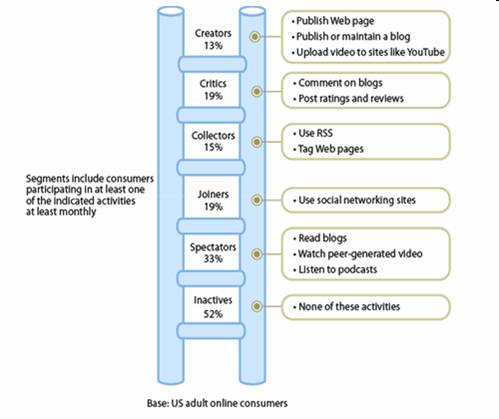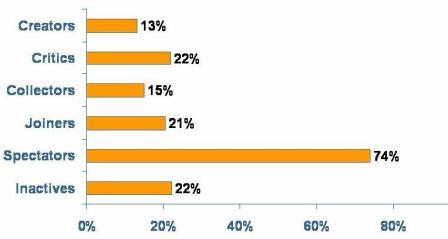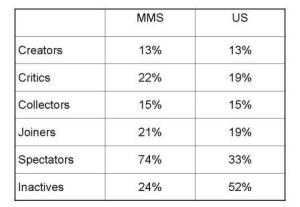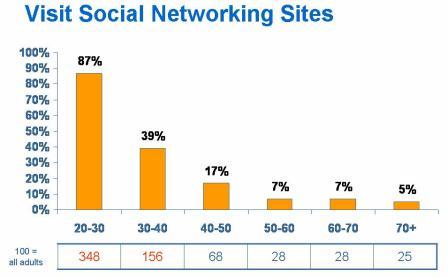My team at the Massachusetts Medical Society has been working on social media technologies for more than two years. In March ’07, we launched our own social network, for members only.
Our results have been OK, but have not matched our hopes. So when we started to do a re-set of our social media strategy and program, we wondered: Were our shortcomings rooted in our strategy, our execution, or our markets? It may be a combination of all three, but which combination? How should we focus our work?
When the book Groundswell unveiled a smart, simple planning model this past spring, we jumped all over it. Authors Charlene Li and Josh Bernoff say you need to start by learning if your markets (members) are actually using social media. In other words, are there any fish in the pond where you want to fish?
We bought a license for a one-time use of Forrester’s survey instrument to learn where our people are playing in the social media world. Forrester’s people studied the results and scored our members on their social technographic profile ladder (see image). Here’s what we learned.
These percentages reflect the MMS members who engage in the activities in those profiles at least once a month.
Now, look at how they compare to Forrester’s survey of all US adults in 2007 (see chart).
This was mind blowing! This survey obliterated most preconceptions we had of a technophobic, conservative membership. Our members use the social media tools at least as frequently as the general public. While these percentages are relatively small in an absolute sense, they have been robust enough to fuel the worldwide social technology engine today.
Below the top line numbers in our survey, there were even more interesting findings:
Members from 25 to 34 are “creators” 38% less frequently than US adults in the same age group. This was a shock. While it could be sampling error, we didn’t think so. We suspect this is because medical students and residents have almost no free time, compared to others in their age group. Residents, for example, average about 80 hours per week on the job. Not many young professionals toil under that kind of workload.
This could be a challenge for us, because folks under 40 are the great engine of the social media world. They create most of the content. So that could be a problem for our efforts.
However, we also learned that our 25-34 year old members are very active in social networks. They are “joiners” 50% more frequently than their peers among the general public. So that’s how they use social media, and that’s where we should fish. We will focus on our social technology efforts on young physicians in online communities.
Next observation: Though smaller in numbers, older physicians are much more willing to experiment in the social media space than other 45+ adults in the US. That’s important, because our median member age is about 50. There is one important exception to this finding – online communities. Starting at age 40, our members’ use of online communities falls off the cliff (see chart). But as Facebook grows, that distinction may also change.
Two more areas where our members participate much more frequently than the average US adult:
- RSS feeds. They use iGoogle, MyYahoo and other widgets, a lot. So we will exploit the living daylights out of inbound and outbound RSS when we launch our new website early next year.
- Ratings and reviews. They read and post ratings and reviews well above national averages. In Forrester’s strategy model, ratings and review could help drive our sales of online education courses, because everyone trusts their peers’ judgment.
It’s clear. Social media technologies can help MMS achieve our objectives and fulfill our mission. Now it’s up to us to plan it right, promote it well, and manage it smartly. (No more excuses. Gulp.)
So I wonder: If our conservative, cautious doctors are ready for it, maybe your people are ready too.




Thanks SO MUCH for sharing, Frank. I am, of course, curious as to how Texas physicians compare to their Yankee colleagues.
Do you mind sharing how much the Forrester license fee was?
Steve
As I’ve said before, I believe the people in the age range 35 – 50 should be known as the “Most Adaptable Generation.” We weren’t raised with technology, but we not only integrated it into our lives, we embraced it.
Frank, this is an awesome summary, thanks very much for sharing. The results are similar to ours after we licensed it also. Steve, the fee was $2500 for a one time usage.
Cheers,
Andy
So how did you reach members to do the survey? Was there a link on your website or did you email them? What was the response rate?
I did a bootleg technographics profile for my association based on demographic data about our membership and I wonder how accurate it is. On one hand, it might be more accurate if the members told us about their online behaviors instead of us just guessing based on their ages and genders, but then again, maybe the response rate wouldn’t be high enough to provide accurate data and the bootleg approach may actually be just as good or better.
Maggie,
Age is still an important factor in web behavior, but I think it is becoming less important as each social media tool moves into the mainstream.
The limitation with demographic research is that it tells you only what you already know – their age, gender, economic status, etc., coupled with what you already think people in these segments do. There is no room for surprises.
The great thing about the Forrester survey instrument is that it asks people what they DO, not who they are (which hopefully you already know anyway). And that difference opens the doors for many new insights.
How we did it: We sent an e-mail to our members, with a link to an online survey tool to collect their responses. It wasn’t Survey Monkey, but something like it. We supported that e-mail with notices in our online and offline newsletters and with a link on the home page of our website. We got about a 15% response, which is typical – and good enough.
What we were told is that if we got at least 100 responses per each major age category (18-25, 25-34, 35-44, 45-54, 55+), that would provide enough of a sample size to draws insights with a fair amount of statistical validity. We did get that.
Thanks for sharing–I agree that age isn’t the most important factor when considering online behavior. I’ll be interested to see how our members’ actual behavior stacks up to what the statistics based on age suggest.
продам Форд-Фокус 2008 года за 200 тр. торг возможет. срочно!!!
+7 960 200 9209